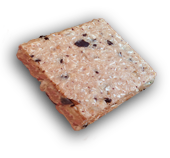While salads maintain platinum status among dieters, client Charlie had a good question to which I’d like to share my response:
Q: When eating a salad with all fresh ingredients from Whole Foods is there any issue with portion size?
A: VEG OUT! Regarding plain, raw fibrous vegetables…go to town! You can eat spinach, field greens, romaine, watercress, broccoli, peppers, snow peas, squash, zucchini, sugar snap peas, celery, cucumber, water chestnuts with abandon.
PROTEIN UP! Top w/ some beans: black, red, edamame…sure, indulge, but don’t put an entire can on. (Vegetarians & vegans: go heavier here). Let it complement the grilled chicken or salmon you put on top of the salad. You can have some unsalted almonds, sunflower seeds or other natural nutty seedy topper, but avoid the typically sugared dried fruit and fried bits such as crispy onions, tortilla strips, croutons, etc. 2tbsp to 1/4 cup max of one nut or total of any combo. Honey roasted peanuts are not the best choice. Unsalted slivered almonds are a winner.
PREMADE = PORTION CONTROL. Exude serious portion control with the premade salads – turkey, chicken, tofu, pasta, potato, egg, even all veggie-based ones are frequently suspended in full-fat mayonnaise, heavy cream, oils and salt. Use your eyes! Salads with clearer liquids often use more vinegar or juice and are typically a better choice than the creamy, opaque ones. Note that many of the soups are also hiding heavy cream, sugar and tons of sodium. (Join me! I still write weekly comment cards requesting low-sodium soups). Fortunately, WF does label each item’s ingredients; however, the caloric breakdown and other nutritional info is nowhere to be found…not even online!
READ INGREDIENTS. But we’re literate adults, so let’s do a quick scan of the ingredients. Avoid entirely or if you absolutely must try it, have only a spoonful of a salad with mayonnaise or heavy cream in the first 5 ingredients. Remember, just like desserts, a spoonful of multiple junk salads certainly add up too. Additionally, if you’re crazy about these salads and soups, you can quickly and easily make low-fat and sodium versions at home using a recipe from my blog. With so many savory and healthy options on the Whole Foods salad bar, you can satisfy your salty, sweet, tangy, garlic-y cravings without derailing your New Year’s resolution.

DRESS FOR THE OCCASION. Finally, watch the type and amount of dressing that you put on that salad. Go with transparent vinaigrettes over creamy opaque dressings. About half of one of those little plastic ramekins equals 2tbsp and is plenty for the huge salads I’m known for. Another way to limit calories and fat in dressing: start with only 1tbsp of a dressing you like, and add another flavor-complementing lower calorie liquid to it, such as vinegar or juice. Try 1 tbsp of straight balsamic vinegar to 1tbsp balsamic vinaigrette and red wine or apple cider vinegar to a fruity dressing. Juice from a freshly squeezed lemon or lime complements most any salad dressing. Ever the inventor, I’m a fan of the Thai vinaigrette, and will add an additional package of low-sodium soy sauce and wasabi. Think more flavor, less fat.
More low fat, flavorFULL options! See blog: SALAD DRESSING ALTERNATIVES
Hope this helps! Keep reading my FITNESS AND FUEL Blog for more fitness and nutrition tips and RRRs (Rotten Recipe Revamps). Got a question for me? Email whitney@fitnessandfuel-la.com and maybe you’ll inspire the next blog!







